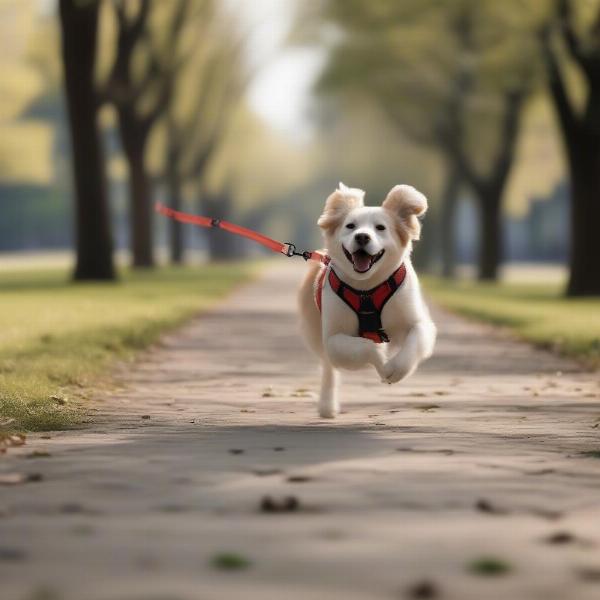A long line for dogs, also known as a training lead, offers a fantastic balance between freedom and control, essential for training and exercising your canine companion. It’s a simple yet powerful tool that can transform your dog’s walks and overall behavior. This article will delve into the benefits, uses, and important considerations when using a long line, empowering you to make informed decisions for your dog’s well-being.
Why Use a Long Line for Dogs?
A long line provides a safe and controlled environment for your dog to explore, build confidence, and practice recall commands. It’s particularly useful for dogs with a strong prey drive or those still learning reliable recall. By offering more freedom than a standard leash, the long line allows your dog to experience a greater sense of independence while still under your supervision. This is crucial for developing a strong bond and encouraging positive behaviors.
 Dog training with a long line
Dog training with a long line
Benefits of Long Line Training
- Improved Recall: Practice recall commands in a larger, more stimulating environment.
- Increased Freedom: Allows your dog to explore and sniff without the restrictions of a short leash.
- Enhanced Safety: Maintains control in potentially hazardous situations.
- Confidence Building: Helps shy or reactive dogs gain confidence in new environments.
- Better Socialization: Facilitates controlled interactions with other dogs.
Choosing the Right Long Line
Selecting the appropriate long line depends on your dog’s size, breed, and training goals. Consider the following factors:
- Material: Biothane is a popular choice for its durability, water resistance, and ease of cleaning. Nylon is a more affordable option but can be less durable.
- Length: Long lines typically range from 10 to 50 feet. Start with a shorter length and gradually increase as your dog’s recall improves.
- Width: Choose a width appropriate for your dog’s size and strength.
- Hardware: Ensure the clips and hardware are sturdy and reliable.
How to Use a Long Line Effectively
Introducing the long line gradually is key to success. Start in a familiar, enclosed area with minimal distractions. Allow your dog to drag the line for a short period, getting accustomed to the feeling. Then, begin practicing recall commands, rewarding your dog with praise and treats for returning to you. Avoid jerking or pulling on the line, as this can create negative associations. Instead, use gentle guidance and positive reinforcement.
Tips for Successful Long Line Training
- Start slow and gradually increase the length.
- Use positive reinforcement.
- Avoid jerking or pulling on the line.
- Practice in different environments.
- Be patient and consistent.
“A long line isn’t just about giving your dog more freedom; it’s about building a stronger bond based on trust and communication,” says renowned dog trainer, Sarah Miller.
Safety Precautions
While long lines offer numerous benefits, safety should always be a priority. Avoid using retractable leashes with long lines, as they can create tangles and injuries. Always supervise your dog closely and be mindful of potential hazards such as other animals, traffic, or obstacles. Choose a well-lit area for training, especially during low-light conditions.
“Remember, a long line is a training tool, not a substitute for a secure fence. Always prioritize your dog’s safety and well-being,” advises veterinary behaviorist, Dr. David Lee.
Conclusion
A long line is a valuable tool for dog owners seeking to improve recall, build confidence, and enhance the bond with their furry friends. By understanding the benefits, choosing the right long line, and using it effectively, you can provide your dog with the freedom to explore while maintaining control and ensuring safety.
FAQ
- What is the best material for a long line? Biothane is a durable, water-resistant, and easy-to-clean option.
- What length long line should I start with? Begin with a shorter length (10-15 feet) and gradually increase as your dog’s recall improves.
- Can I use a long line with a retractable leash? No, retractable leashes should not be used with long lines due to safety concerns.
- Is a long line suitable for all dogs? Yes, with proper training and supervision, long lines can benefit dogs of all sizes and breeds.
- How do I prevent my dog from getting tangled in the long line? Practice in open areas with minimal obstacles and supervise your dog closely.
- What are the benefits of using a long line? Improved recall, increased freedom, enhanced safety, confidence building, and better socialization.
- How do I clean a biothane long line? Simply wipe it down with a damp cloth or rinse it with water.
Related Articles
ILM Dog is a leading online resource for dog owners worldwide, offering expert advice and practical tips on all aspects of dog care, from breed selection and health to training and nutrition. Our mission is to empower dog owners with the knowledge and resources they need to provide their furry companions with a happy, healthy, and fulfilling life. For personalized guidance on dog training, nutrition, or product recommendations, reach out to our team of experts. Contact us at [email protected] or +44 20-3965-8624. Visit ILM Dog for more valuable information and resources to enhance your dog’s well-being.